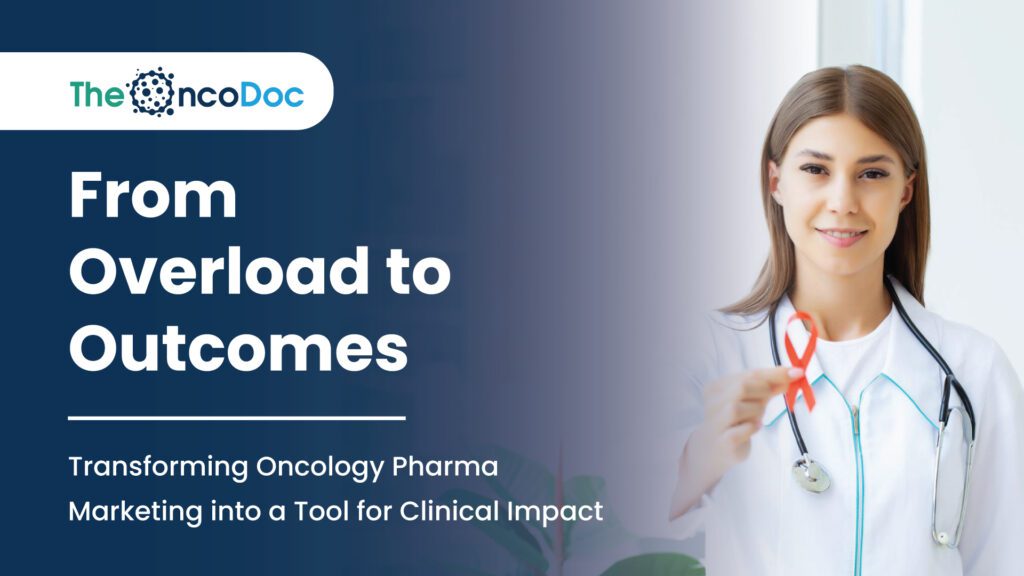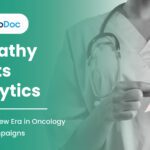Introduction: Rethinking Digital Influence in Cancer Care
In the high-stakes world of oncology, every interaction, be it a consultation, a clinical decision, or even a digital impression, carries weight. And yet, much of today’s pharma marketing operates on outdated paradigms: maximizing impressions, boosting click-through rates, or increasing brand recall without considering the critical clinical environments oncologists work within.
As oncology becomes more complex with emerging biomarkers, immunotherapies, and patient-specific pathways, pharma marketers must pivot. The role of marketing in oncology is no longer just to inform, it’s to empower. Today, brand success lies in being clinically relevant, scientifically sound, emotionally resonant, and digitally present; without being digitally overbearing.
This article explores how oncology pharma marketing can evolve into a strategic enabler of clinical care, with new frameworks, real-world content strategies, and AI-powered personalization, all focused on delivering measurable, meaningful impact.
Section 1: The Changing Landscape of Oncology Marketing; From Loud to Useful
The COVID-19 pandemic catalyzed digital transformation across healthcare, but in its wake, many oncologists now face an overwhelming barrage of pharma communications. Quantity has increased, but quality remains elusive. As oncologists shift toward precision-driven, patient-centered care, they demand messaging that’s relevant, timely, and clinically actionable.
A 2023 survey of 850 Indian oncologists highlights the disconnect:
- 61% reported receiving over 20 pharma emails weekly
- Only 9% found more than three of those emails to be clinically valuable
This data clearly signals a shift: Relevance is the new reach. Pharma marketers can no longer afford to rely on volume-based digital tactics; the new mandate is personalization, context, and utility.
Trends Redefining Oncology Pharma Marketing:
- Precision medicine evolution: Oncologists now seek mutation-specific, region-specific insights for informed treatment decisions
- Hybrid rep engagement: Digital and in-person detailing must be complementary, not competing
- Information fatigue: Bite-sized, micro-content formats outperform long presentations
Modern oncologists are not passive targets of brand messaging, they are evidence-driven decision-makers seeking tools that fit into real-world workflows. For pharma brands to remain credible, communications must move from broadcasting products to solving problems. The future of oncology marketing lies not in being louder, but in being undeniably useful.
Section 2: Embedding Clinical Value into Every Campaign
Go Beyond Awareness; Enable Action
Modern pharma campaigns must bridge the gap between brand information and clinical utility. Instead of promoting “what the drug is,” marketers must show “how the drug helps” in nuanced clinical scenarios.
Recommended Content Pillars:
- Decision-support tools: e.g., metastatic sequencing guides.
- Dosing calculators: customized for hepatic or renal impairments.
- Real-time drug interaction checkers for combination therapies.
- Side-effect mitigation maps: segmented by patient subtype.
Case Snapshot: A leading pharma brand in breast oncology created a downloadable “Switch Navigator” tool guiding oncologists on when and how to transition patients from chemotherapy to CDK4/6 inhibitors. Result? A 22% rise in brand conversations and a threefold increase in tool downloads.
Section 3: Locate Practical Evidence to Increase Clinical Significance
Though oncologists in India, Southeast Asia (SEA), and the Middle East & North Africa (MENA) are increasingly prioritizing indigenous evidence, global clinical trials provide scientific rigor.
What Local Data Can Achieve:
To address this gap, pharma marketers must pivot from generic global data to real-world evidence (RWE) grounded in regional contexts. This approach builds trust, drives adoption, and enhances clinical utility.
Strategic Approaches Include:
- Commissioning regional case studies from oncology centers in cities like Nagpur, Hanoi, or Lagos
- Publishing outcomes from local observational cohorts (e.g., diabetic cancer patients in Tamil Nadu or high-altitude lung cancer in Nepal)
· Creating “State of Cancer” dashboards that display incidence, survival, and access data by state or district
· Mapping regional obstacles to patient adherence (shame, expense, and travel) and providing specialized support resources
A 2024 HCP preference study involving 1,200 oncologists across India, SEA, and MENA revealed distinct patterns in data expectations:
The data shows a clear trend: local evidence trumps global citations in terms of perceived relevance, especially in India and SEA. Pharma marketers who invest in local storytelling, data generation, and regional insights will command greater influence and clinical traction.
Section 4: The Rise of Micro-Moments in HCP Engagement
In oncology, where every decision is time-sensitive, oncologists increasingly prefer micro-content over long-form resources. Traditional content formats like webinars, lengthy PDFs, or dense clinical papers are losing ground to digestible, quick-access formats that fit into the daily rhythm of an HCP’s clinical practice.
What Works Today:
- 1-minute MOA videos demonstrating drug mechanisms visually
- Infographic PDFs summarizing the latest NCCN or ASCO guideline updates
- “Ask Me Anything” threads on Telegram/WhatsApp with KOLs
- Printable checklists for patient supportive care (e.g., chemo readiness, nutritional support)
These formats cater to “micro-moments”, short windows when oncologists actively seek relevant content, such as between consultations or while commuting. A 2024 AI-driven campaign conducted across 500 oncologists in Tier 1 and Tier 2 Indian cities revealed compelling outcomes:
- 44% increase in open rates for 90-second email video updates compared to standard newsletters
- 37% higher downloads for vernacular “doctor-to-patient” education kits
- 29% more engagement in group chats when clinical summaries were shared as carousel posts rather than static PDFs
This shift reflects a broader trend, utility with brevity. Engagement, recollection, and subsequent prescribing behavior are all directly increased when oncologists’ time and information needs are met.
Micro-moment strategies, when personalized and localized, are not just efficient, they’re becoming essential for pharma marketers in oncology.Top of FormBottom of Form
Section 5: Empowering Patient Communication Through Digital Aids
Most oncologists spend 30–40% of their time explaining treatment to patients and caregivers. Pharma can play a vital role here, not by replacing the physician voice, but by amplifying it.
Patient-Enabling Tools:
- Multilingual explainer videos (immunotherapy, oral chemo)
- “What to Expect” guides before radiation
- Consent form FAQs
- “Ask Your Doctor” checklists to empower informed questions
- Nutrition and lifestyle posters co-created with cancer dietitians
Example: A pharma-patient initiative in Karnataka distributed QR-coded chemo prep videos in Kannada, Tamil, and Hindi. These were viewed over 12,000 times in 6 weeks and shared by 65% of the oncologists in the pilot program.
Section 6: Personalization with Purpose; AI-Driven HCP Segmentation
Not all oncologists are the same, yet pharma marketing often treats them so. AI tools can segment HCPs based on prescribing behavior, content interaction, clinical interest, and even digital fatigue level.
Key Segments:
- “Digital Explorers”: Open to webinars, whitepapers, and LinkedIn content
- “Tactical Seekers”: Prefer checklists, guides, and treatment algorithms
- “Time-Strapped Decision Makers”: Only engage with high-value calculators or patient material
With AI, campaigns can dynamically adapt:
- Email subject lines based on specialty (e.g., thoracic vs gynecologic)
- Webinar invites aligned to previously consumed content
- Smart chatbots that remember previous queries
Impact: Personalized campaigns have shown 3x engagement rates and 1.8x higher CTRs in oncology compared to generic communication.
Section 7: Rethinking Field Force in a Digital World
Field reps remain critical, but their role is evolving. No longer just the “voice of the brand,” they must now act as curators of digital value.
New Expectations from Field Teams:
- Understand content analytics (e.g., who opened what)
- Use engagement dashboards to prioritize visits
- Tailor discussions to HCP digital behavior
- Share post-meeting summaries via WhatsApp/Email with relevant tools
MSLs (Medical Science Liaisons) must:
- Lead peer discussions on clinical challenges
- Translate real-world evidence into local context
- Partner with digital teams to feed back field insights
Section 8: Closing the Feedback Loop with Smarter, Outcome-Focused Metrics
Oncology pharma marketing can no longer afford to rely on vanity metrics like email open rates or social media likes. As content becomes more personalized and clinically relevant, performance measurement must evolve to capture real-world value, not just digital noise.
What Should Be Measured:
Modern metrics must reflect how content informs clinical behavior, supports patient care, and builds trust over time.
Recommended Value Metrics:
- Tool re-visits per oncologist per month to track ongoing engagement
- Clinic-level downloads of patient education tools (e.g., explainer kits or treatment diaries)
- Share rate of MOA (Mechanism of Action) videos, especially across closed peer networks
- Sentiment scores from post-engagement surveys measuring perceived clinical usefulness
- Number of follow-up inquiries to MSLs (Medical Science Liaisons) after digital campaigns
These metrics go beyond clicks and impressions. They reveal intent, trust, and knowledge transfer, the real markers of impactful engagement in oncology.
Pro Tip: Integrate micro-surveys within your platforms. Simple prompts like “Did this content help in your last patient case?” or “Would you recommend this resource to a colleague?” offer high-quality feedback at scale.
By focusing on actionable insights over surface metrics, pharma marketers can better understand oncologists’ evolving needs and continuously refine content to drive both clinical value and brand credibility.
Section 9: Collaborating with Ecosystem Players for Scale, Trust, and Reach
In oncology, no single entity can drive lasting impact alone. Pharma brands must move beyond isolated campaigns and engage with ecosystem players who are deeply embedded in the patient journey. Strategic collaborations foster trust, unlock new access points, and scale initiatives with credibility.
Key Ecosystem Collaborators:
- Cancer NGOs: For survivor-led storytelling, awareness in regional languages, and grassroots outreach
- Government health bodies: To integrate campaigns with national or state screening programs, especially in underserved Tier 2/3 regions
- Academic and teaching hospitals: For real-world evidence generation, co-authored whitepapers, and CME content
- Patient advocacy and support groups: To co-develop financial navigation tools and psychosocial support systems
These partnerships bring authenticity and community trust, elements that no marketing budget can buy. They also ensure that AI tools, educational materials, or digital platforms are shaped by real-world needs, not just brand priorities.
Case Study:
In Maharashtra (2023), a collaboration between a leading oncology pharma brand, a local cancer NGO, and the state health department resulted in the development of an AI-powered Early Referral Tool for breast cancer. Piloted in three districts, the tool reduced average diagnosis timelines by 32%, especially in rural clinics with delayed access.
Such public-private models demonstrate how pharma can go from being just a product provider to a partner in care delivery, a transformation essential for both impact and relevance in the oncology landscape.
Section 10: Future-Proofing Your Oncology Brand
As AI, real-world evidence, and hyper-personalization reshape the healthcare landscape, oncology pharma brands must evolve from being promoters to clinical partners. Staying relevant requires more than digital presence, it demands purpose-driven engagement grounded in utility and trust.
The Future-Ready Oncology Brand Will:
- Offer practical tools, not just promotional taglines
- Prioritize clinical workflows, not digital vanity metrics
- Focus on measurable outcomes, beyond surface-level awareness
- Balance the oncologist’s logic with the patient’s lived reality
- Build long-term trust by collaborating with communities, not just providers
The next generation of impactful brands will be those that embed themselves into the daily rhythm of care, solving real problems, reducing friction, and enabling better decision-making.
Ultimately, future-proofing is not about chasing the latest trend. It’s about earning a place in the clinician’s mind and the patient’s journey, by being clinically indispensable and emotionally resonant.
Final Thoughts: From Clicks to Care
Pharma marketing in oncology must be redefined not just by what we create, but by how it’s used at the point of care.
When every email, video, calculator, or patient tool becomes an enabler of better decisions, faster diagnosis, clearer communication, or compassionate care, pharma evolves from vendor to partner, from noise to necessity.
As oncologists navigate one of the most emotionally and clinically complex fields in medicine, your brand’s digital touchpoint should be the one that makes them pause, think, and say:
“This helps.”
That’s the new gold standard of success in oncology pharma marketing.
The Oncodoc team is a group of passionate healthcare and marketing professionals dedicated to delivering accurate, engaging, and impactful content. With expertise across medical research, digital strategy, and clinical communication, the team focuses on empowering healthcare professionals and patients alike. Through evidence-based insights and innovative storytelling, Hidoc aims to bridge the gap between medicine and digital engagement, promoting wellness and informed decision-making.



